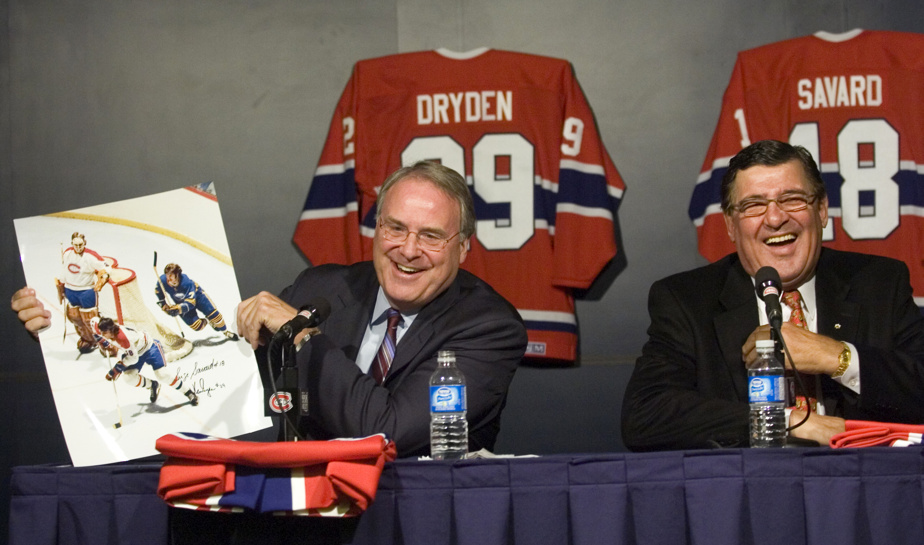It is the story of a statue or perhaps a myth. It’s the story of a goalkeeper and his pose, famous as much as his exploits, which remains buried in so many memories after so many years.
First, it is the story, immortalized forever, of a goalkeeper who was too tall, who had to invent a respite position instead of doing like all the others, who rested by leaning on their pads. .
This is what grew the legend of Ken Dryden, and in turn, what led to this statue, named The Goalie – The Guardian -, created in 1985 by the artist Robin Bell, in Italy, “from the quarries that Michelangelo frequented”, according to Dryden.
Over time, the work has moved three times: from Place Vertu in 1985 to Place Montréal Trust in 2011, and then finally here, in front of the Raymond-Bourque arena, in the Saint-Laurent borough.
When celebrating this third (and final?) move on Saturday, Alan DeSousa, mayor of Saint-Laurent, talked about how something had to be done to give more visibility to The Goalie, previously abandoned in a corner of Place Montréal Trust in the city center. “It was there, covered in dust, and no one knew it was there anymore,” Mr. DeSousa said.

PHOTO JOSIE DESMARAIS, THE PRESS
Alan DeSousa
There are players who leave their mark on generations for a host of reasons: goals, points, great triumphs. Dryden, who kept the Canadian’s net during the great dynasty of the 1970s, marked the imagination as much by his triumphs as by his mask and this pose.
It still surprises him.
When we think of players, in any sport, we think of them while they are in action, not while they are not. Now when you remember me, that’s what you remember…
Ken Dryden
He recalls that in the past, people tried to give him a nickname: the Shepherd. “It was perfect, because that’s the job of the guard: to keep an eye on things, to make sure everything is going well,” he adds with a smile.
To this day, nearly 45 years after his retirement, Dryden is still defined by this image of himself. That of the cerebral guardian, who is above the fray and on top of his affairs, unwavering in the face of adversity. It’s an image that he skillfully cultivated during his eight seasons on the ice of the NHL.

PHOTO ANTOINE DESILETS, LA PRESSE ARCHIVES
Ken Dryden in May 1971
For reasons of rest, of course, but also because it sent a strong message to the rest of the league.
“It projected calm and confidence,” he adds. This is a very important message to convey to your teammates, to the fans, and also to the other team. Teammates need to know that everything is fine behind them, and opponents need to know that they won’t be able to reach the guy at the other end.
“I remember the press conference for the withdrawal of my jersey and that of Serge Savard [en 2006]… We brought a photo of the two of us, taken during a game against Buffalo; we see Serge who has the puck, he goes behind the net, and Richard Martin is chasing him… Martin was a great scorer, and in the photo, he is just behind Serge. He could take the puck from him, and I’m there, standing, leaning on my net, as if nothing had happened. If there’s anything to sum up what it was like for us in the 1970s, it’s this. »

PHOTO IVANOH DEMERS, LA PRESSE ARCHIVES
Serge Savard and Ken Dryden present the famous photo on the day their jerseys were retired, in 2006.
The city at their feet
At 76, Dryden hasn’t played hockey for a long time, but he hasn’t forgotten anything about what he experienced here, when the Canadian, the city at his feet, was not allowed to lose.
“We often talk about the eight-loss season (1976-1977), but from that one, I think we lost something like 30 games in three years… We all found ourselves in the right place, at the right time, surrounded by the best people. We had the best GM in history in Sam Pollock, the best coach in history in Scotty Bowman, and we had the best players, in the best arena, and in front of the best fans, who were the most passionate, engaged, the greatest connoisseurs. It forced us to give the best of ourselves.
“The message from the media, the fans, the management was that we had to realize how good we were. Once we realize this, we have no right not to be as good as we are capable of being. If we beat the Blues 5-3 and it was an ordinary performance, we knew we had to be better. »

PHOTO JOSIE DESMARAIS, THE PRESS
The statue of Ken Dryden in front of the Raymond-Bourque arena, in the borough of Saint-Laurent
Dryden agrees that times have changed, hockey too, but this so “Montreal” pressure, which we come out with every time to partly explain the absence of great triumphs since the last one, in 1993, also existed in his time .
Only, she didn’t reach this version of the club, and even less so this goalkeeper who rested his chin on his stick to relax between two stops.
“It makes for a difficult environment, because you always have to reach a standard,” he admits. But it’s the right environment and it’s the right standard to aim for. We knew we were good and better than our opponents. »
The season where we lost these eight games, why did we lose them? We were better than all these teams.
Ken Dryden
As an example, Dryden brings up a quote from tennis player Billie Jean King: pressure is a privilege. “That’s a good quote… The challenge is when you’re expected to be better than you actually are; that’s difficult. Pressure can make you a little better, but when expectations go beyond that, that pressure can be disturbing, because you can’t reach that standard that people demand. »
And if a member of the current edition of the Canadiens needs a little inspiration, they can always go and pay their respects in front of the statue of Ken Dryden, a tribute to a more glorious era, when victory was such a certainty that the goalkeeper could afford such a pose.
“When you’re as good as expectations, there’s no better place to play hockey than Montreal or Toronto,” concluded the Canadian legend. But if you can’t do it, it can be really difficult…”
